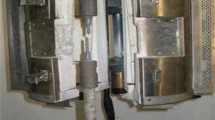Abstract
The creep deformation of the ductile two-phase alloys was analysed on the basis of the continuum mechanics model which incorporated the Θ projection concept proposed by Evans and Wilshire. The calculated creep curves were compared with the experimental ones in ferrjte-pearlite steels. It was found that the continuum mechanics model was able to predict the whole creep deformation process of the ductile two-phase alloys from the onset of creep loading to the final rupture, if the creep-deformation and creep-rupture data of the individual phases which constituted the two-phase alloys were known. A “steady-state creep” in the ductile two-phase alloys was predicted by the continuum mechanics model to occur, even if the constituent phases did not have the inherent steady-state creep. This was caused by the internal stresses arising from the creep-strength difference between second-phase and matrix in the two-phase alloys. This steady-state creep was observed in ferrite-pearlite steels during creep at 873 K. The predicted rupture life on the basis of the continuum mechanics model was correlated well with the experimental results in ferrite-pearlite steels, although the former was somewhat shorter than the latter under higher creep stresses. The continuum mechanics model was able to apply to the life prediction and the creep-strength design of the ductile two-phase alloys.
Similar content being viewed by others
References
A. H. Sully, “Metallic Creep and Creep Resistant Alloys” (Butterworths Scientific, London, 1949) p. 37.
F. K. G. Odqvist and J. Hult, “Kriechfestigkeit Metallischer Werkstoffe”, translated by S. Murakami (Baifukan, Tokyo, 1967) p. 73.
F. Garofalo, “Fundamentals of Creep and Creep-Rupture in Metals”, translated by M. Adachi, (Maruzen, Tokyo, 1968) p. 10.
V. Lupinc, in “Creep and Fatigue in High Temperature Alloys”, edited by J. Bressers (Applied Science, London, 1981) p. 7.
R. W. Evans and B. Wilshire, “Creep of Metals and Alloys” (The Institute of Metals, London, 1985) p. 189.
R. W. Evans, P. J. Scharning and B. Wilshire, in “Creep Behaviour of Crystalline Solids”, edited by B. Wilshire and R. W. Evans (Pineridge Press, Swansea, 1985) p. 201.
M. Tanaka, T. Sakaki and H. Iizuka, Acta Metall. Mater. 39 (1991) 1549.
J. D. Eshelby, Proc. R. Soc., A241 (1957) 376.
T. Mura and T. Mori, “Micromechanics” (Baifukan, Tokyo, 1976) p. 23.
T. Mura, “Micromechanics of Defects in Solids” (Martinus Nijhoff, The Hague, 1982) p. 63.
T. Mori and K. Tanaka, Acta Metall. 21 (1973) 571.
K. Tanaka and T. Mori, ibid. 18 (1970) 931.
Technical Data, “Elastic Moduli of Metallic Materials”, (Japan Society of Mechanical Engineers, Tokyo, 1980) p. 137.
Author information
Authors and Affiliations
Rights and permissions
About this article
Cite this article
Tanaka, M. Prediction of creep deformation in ductile two-phase alloys by a continuum mechanics model. JOURNAL OF MATERIALS SCIENCE 28, 2750–2756 (1993). https://doi.org/10.1007/BF00356213
Received:
Accepted:
Published:
Issue Date:
DOI: https://doi.org/10.1007/BF00356213




